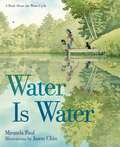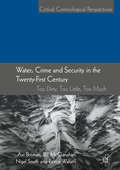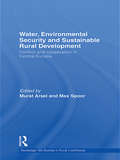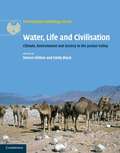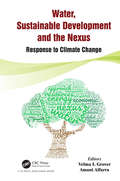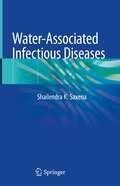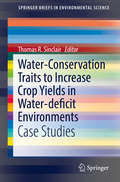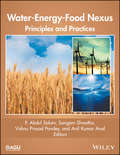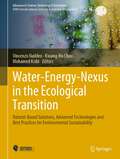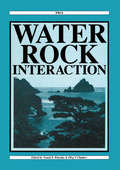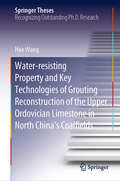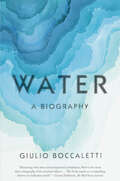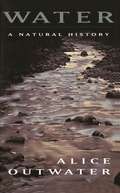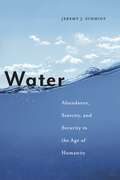- Table View
- List View
Water in the Universe
by Arnold HanslmeierDue to its specific chemical and physical properties, water is essential for life on Earth. And it is assumed that this would be the case for extraterrestrial life as well. Therefore it is important to investigate where water can be found in the Universe. Although there are places that are completely dry, places where the last rainfall happened probably several 100 million years ago, surprisingly this substance is quite omnipresent. In the outer solar system the large satellites of Jupiter and Saturn are covered by a thick layer of ice that could be hiding a liquid ocean below. This of course brings up the question of whether the recently detected extrasolar planets could have some water on their surfaces and how we can detect this. Water molecules are also found in interstellar gas and dust clouds. This book begins with an introductory chapter reviewing the physical and chemical properties of water. Then it illuminates the apparent connection between water and life. This is followed by chapters dealing with our current knowledge of water in the solar system, followed by a discussion concerning the potential presence and possible detection of water on exoplanets. The signature of water in interstellar space and stars are reviewed before the origin of water in the Universe is finally discussed. The book ends with an appendix on detection methods, satellite missions and astrophysical concepts touched upon in the main parts of the book. The search for water in the Universe is related to the search for extraterrestrial life and is of fundamental importance for astrophysics, astrobiology and other related topics. This book therefore addresses students and researchers in these fields.
Water is Water: A Book about the Water Cycle
by Jason Chin Miranda PaulThis spare, poetic picture book follows a group of kids as they move through all the different phases of the water cycle. From rain to fog to snow to mist, talented author Miranda Paul and the always remarkable Jason Chin (Redwoods, Coral Reefs, Island, Gravity) combine to create a beautiful and informative journey in this innovative nonfiction picture book that will leave you thirsty for more.
Water is for Fighting Over: and Other Myths about Water in the West
by John FleckWhen we think of water in the West, we think of conflict and crisis. In recent years, newspaper headlines have screamed,"Scarce water and the death of California farms," "The Dust Bowl returns," "A 'megadrought' will grip U.S. in thecoming decades." Yet similar stories have been appearing for decades and the taps continue to flow. John Fleck arguesthat the talk of impending doom is not only untrue, but dangerous. When people get scared, they fight for the last drop ofwater; but when they actually have less, they use less.Having covered environmental issues in the West for a quarter century, Fleck would be the last writer to discount theserious problems posed by a dwindling Colorado River. But in that time, Fleck has also seen people in the Colorado RiverBasin come together, conserve, and share the water that is available. Western communities, whether farmers and city-dwellers or US environmentalists and Mexican water managers, have a promising record of cooperation, a recordoften obscured by the crisis narrative.In this fresh take on western water, Fleck brings to light the true history of collaboration and examines the bondscurrently being forged to solve the Basin's most dire threats. Rather than perpetuate the myth "Whiskey's for drinkin', water's for fightin' over," Fleck urges readers to embrace a new, more optimistic narrative--a future where the Colorado continues to flow.
Water without Borders?
by Karen Bakker Emma S. Norman Alice CohenSince 1909, the waters along the Canada-US border have been governed in accordance with the Boundary Water Treaty, but much has changed in the last 100 years. This engaging volume brings together experts from both sides of the border to examine the changing relationship between Canada and the US with respect to shared waters, as well as the implications of these changes for geopolitics and the environment. Water without Borders? is a timely publication given the increased attention to shared water issues, and particularly because 2013 is the United Nations International Year of Water Cooperation.Water without Borders? is designed to help readers develop a balanced understanding of the most pressing shared water issues between Canada and the United States. The contributors explore possible frictions between governance institutions and contemporary management issues, illustrated through analyses of five specific transboundary water "flashpoints." The volume offers both a historical survey of transboundary governance mechanisms and a forward-looking assessment of new models of governance that will allow us to manage water wisely in the future.
Water, Climate Change, and Sustainability
by Sangam Shrestha Vishnu Prasad Pandey David WibergAn in-depth review of sustainable concepts in water resources management under climate change Climate change continues to intensify existing pressures in water resources management, such as rapid population growth, land use changes, pollution, damming of rivers, and many others. Securing a reliable water supply—critical for achieving Sustainable Development Goals (SDGs)—requires understanding of the relation between finite water resources, climate variability/change, and various elements of sustainability. Water, Climate Change, and Sustainability is a timely and in-depth examination of the concept of sustainability as it relates to water resources management in the context of climate change risks. Featuring contributions by global authors, this edited volume is organized into three sections: Sustainability Concepts; Sustainability Approaches, Tools, and Techniques; and Sustainability in Practice. Detailed chapters describe the linkage between water and sustainable development, highlight the development and use of new measuring and reporting methods, and discuss the implementation of sustainability concepts in various water use sectors. Topics include localizing and mainstreaming global water sustainability initiatives, resilient water infrastructure for poverty reduction, urban water security for sustainable cities, climate actions and challenges for sustainable ecosystem services, and more. This important resource: Reviews contemporary scientific research and practical applications in the areas of water, climate change and sustainability in different regions of the world Discusses future directions of research and practices in relation to expected patterns of climate changes Covers a wide range of concepts, theories, and perspectives of sustainable development of water resources Features case studies of field and modelling techniques for analyzing water resources and evaluating vulnerability, security, and associated risks Discusses practical applications of water resources in contexts such as food security, global health, clean energy, and climate action Water, Climate Change, and Sustainability is an invaluable resource for policy makers water managers, researchers, and other professionals in the field, and an ideal text for graduate students in hydrogeology, climate change, geophysics, geochemistry, geography, water resources, and environmental science.
Water, Crime and Security in the Twenty-First Century: Too Dirty, Too Little, Too Much (Critical Criminological Perspectives )
by Avi Brisman Nigel South Reece Walters Bill McClanahanWater, Crime and Security in the Twenty-First Century represents criminology’s first book-length contribution to the study of water and water-related crimes, harms and security. The chapters cover topics such as: water pollution, access to fresh water in the Global North and Global South, water and climate change, the commodification of water and privatization, water security and pacification, and activism and resistance surrounding issues of access and pollution. With examples ranging from Rio de Janeiro to Flint, Michigan to the Thames River, this original study offers a comprehensive criminological overview of the contemporary and historical relationship between water and crime. Coinciding with the International Decade for Action, “Water for Sustainable Development,” 2018–2028, this timely volume will be of particular relevance to students and scholars of green criminology, as well as those interested in critical geography, environmental anthropology, environmental sociology, political ecology, and the study of corporate crime and state crime.
Water, Cryosphere, and Climate Change in the Himalayas: A Geospatial Approach (Geography of the Physical Environment)
by Kireet Kumar Ajay Kumar Taloor Bahadur Singh KotliaThis edited book summarizes numerous research studies on remote sensing and GIS of natural resource management for the Himalaya region done by Indian Institutions and Universities over the last decade. It gives an overview of hydrometeorological studies on Himalayan water resources and addresses concerns in the development of water resources in this region, which is dealing with an increased pressure in population, industrialization and economic development. While the source of some of the major rivers of India are found in the Himalayas, the glaciers and water bodies in the region are continuously shrinking leading to a depletion of water and deterioration of water quality. This is affecting a population of up to 2.5 billion people. The ecosystems have been under threat due to deforestation, loss of biodiversity, expansion of agriculture and settlement, overexploitation of natural resources, habitat loss and fragmentation, poaching, mining, construction of roads and large dams, and unplanned tourism. Spaceborne remote sensing with its ability to provide synoptic and repetitive coverage has emerged as a powerful tool for assessment and monitoring of the Himalayan resources and phenomena. This work serves as a resource to students, researchers, scientists, professionals, and policy makers both in India and on a global level.
Water, Earth, and Man: A Synthesis of Hydrology, Geomorphology, and Socio-Economic Geography (Routledge Revivals)
by Richard J. ChorleyFirst published in 1969, Water, Earth, and Man, was written to demonstrate the advantages of adopting a unified view of the earth and social sciences. The book considers the connection between an understanding of physical environments and an understanding of social environments. It explores the hydrologic cycle and highlights the significance of the relationship between natural environments and the activities of humankind, drawing together physical and human geography to produce a highly detailed study.
Water, Environmental Security and Sustainable Rural Development: Conflict and Cooperation in Central Eurasia (Routledge Iss Studies In Rural Livelihoods Ser.)
by Max Spoor Murat ArselThis co-edited volume provides a unified scholarly treatment of intensifying debates on the relationship between water scarcity and environmental security in Central Eurasia. Using discussions of sustainable rural development as its conceptual backdrop, the chapters in this volume combine solid empirical investigation with critical analysis of key concepts such as ‘scarcity’, ‘expert knowledge’, and ‘efficiency’. The central theme emerging from the contributions emphasizes the need to reevaluate accepted wisdom in resource studies that considers distributional conflicts over water usage as inherently zero-sum outcomes in which one player’s gains inevitably correspond to another player’s losses. Instead, the empirical and critical analyses in this book demonstrate that effective management of water resources can be re-conceptualized as the basis for regional cooperation and sustainable rural development.
Water, Flood Management and Water Security Under a Changing Climate: Proceedings from the 7th International Conference on Water and Flood Management
by Anisul Haque Ahmed Ishtiaque Amin ChowdhuryThis book presents selected papers from the 7th International Conference on Water and Flood Management,with a special focus on Water Security under Climate Change, held in Dhaka, Bangladesh in March 2019. The biennial conference is organized by Institute of Water and Flood Management of Bangladesh University of Engineering and Technology. The recent decades have experienced more frequent natural calamities and it is believed that climate change is an important driving factor for such hazards. Each part of the hydrological cycle is affected by global climate change. Moreover, increasing population and economic activities are posing a bigger threat to water sources. To ensure sustainable livelihoods, safeguard ecosystem services, and enhance socio-economic development, water security needs to be investigated widely in a global and regional context.
Water, Life and Civilisation
by Steven Mithen Emily BlackA unique interdisciplinary study of the relationships between climate, hydrology and human society from 20,000 years ago to the present day within the Jordan Valley. It describes how state-of-the-art models can simulate the past, present and future climates of the Near East, reviews and provides new evidence for environmental change from geological deposits, builds hydrological models for the River Jordan and associated wadis and explains how present day urban and rural communities manage their water supply. The volume provides a new approach and new methods that can be applied for exploring the relationships between climate, hydrology and human society in arid and semi-arid regions throughout the world. It is an invaluable reference for researchers and advanced students concerned with the impacts of climate change and hydrology on human society, especially in the Near East.
Water, Sustainable Development and the Nexus: Response to Climate Change (Water)
by Velma I. Grover Amani AlfarraWater is intricately linked with food security, energy security, and sustainable development. As the world is moving towards sustainable development goals, it is critical to recognize the role of water in attaining these goals. The Water-Energy-Food Nexus draws attention to the complex and interrelated nature of global resource systems and forces us to think about how a decision in one sector impacts other interlinked sectors as well. This book looks at the three dimensions of sustainable development-environment, economics and society-and how water is linked with them and explores the nexus approach as a framework to look at the issues and identify solutions.
Water-Associated Infectious Diseases
by Shailendra K. SaxenaThis book provides a comprehensive overview of the different water-associated infectious diseases and their linked pathogens with plausible strategies for their mitigation. Although, we are in the era of 21st century having most of the advanced technologies at hand, yet water-associated infectious diseases are the major contributors towards the worldwide morbidity and mortality. The book also focuses on the various implementation strategies of sustainable hygienic conditions, discusses the robust, and reliable policies and strategies on a global aspect to provide unprivileged people access to the basic sanitation, hygiene and water. In addition, the book discusses the possible indirect effect of global warming on the spread of infectious diseases through the distribution of associated vectors.
Water-Carbon Dynamics in Eastern Siberia (Ecological Studies #236)
by Tetsuya Hiyama Takeshi Ohta Yoshihiro Iijima Ayumi Kotani Trofim C. MaximovThis book discusses the water and carbon cycle system in the permafrost region of eastern Siberia, Providing vitalin sights into how climate change has affected the permafrost environment in recent decades. It analyzes the relationships between precipitation and evapotranspiration, gross primary production and runoff in the permafrost regions, which differ from those intropical and temperate forests. Eastern Siberia is located in the easternmost part of the Eurasian continent, and the land surface with underlying permafrost has developed over a period of seventy thousand years. The permafrost ecosystem has specific hydrological and meteorological characteristics in terms of the water and carbon dynamics, and the current global warming and resulting changes in the permafrost environment are serious issues in the high-latitude regions. The book is a valuable resource for students, researchers and professionals interested in forest meteorology and hydrology, forest ecology, and boreal vegetation, as well as the impact of climate change and water-carbon cycles in permafrost and non-permafrost regions.
Water-Conservation Traits to Increase Crop Yields in Water-deficit Environments
by Thomas R. SinclairThis volume explores specific approaches that have shown to result in crop yield increases. Research on the physiological understanding of these methods has led to the development of practical applications of plant breeding approaches to genetically improve crops to achieve higher yields. Authoritative entries from crop scientists shed new light on two water-conservation traits: one that is based on an initiation of the decrease in transpiration earlier in the soil drying cycle, and the second that is based on a sensitivity of transpiration rate under high atmospheric vapor pressure deficit that results in partial stomatal closure. Both these approaches involve partial stomatal closure under well-defined situations to decrease the rate of soil water loss. Readers will be able to analyze the circumstances under which a benefit is achieved as a result of the water-limitation trait; and key discussion points in the case studies presented will help answer questions such as what species, which environments, how often will yield be benefited for various crop species? Contributions also review the genetic variation for these two traits within each crop species and the physiological basis for the expression of these traits.
Water-Energy-Food Nexus: Principles and Practices
by Anil K. Anal Sangam Shrestha P. Abdul Salam Vishnu Prasad PandeyWater, energy and food are key resources to sustain life, and are the fundamental to national, regional and global economies. These three resources are interlinked in multiple ways, and the term “nexus” captures the interconnections. The nexus has been discussed, debated, researched, and advocated widely but the focus is often on the pairings of “water-energy” or “water-food” or “energy-food”. To really benefit from the nexus approach in terms of resource use efficiency it is essential to understand, operationalize and practice the nexus of all three resources. As demand for these resources increases worldwide, using them sustainability is a critical concern for scientists and citizens, governments and policy makers. Volume highlights include: Contributions to the global debate on water-energy-food nexus Examples of the nexus approach in practice from different regions of the world Perspectives on the future of the nexus agenda Water-Energy-Food Nexus: Theories and Practices is a valuable resource for students, research scholars and professionals in academic institutions with strong interests in interdisciplinary research involving geography, earth science, environmental science, environmental management, sustainability science, international development, and ecological economics. The volume will also be useful for professionals, practitioners and consultants in /NGOs, government, and international agencies.
Water-Energy-Nexus in the Ecological Transition: Natural-Based Solutions, Advanced Technologies and Best Practices for Environmental Sustainability (Advances in Science, Technology & Innovation)
by Vincenzo Naddeo Mohamed Ksibi Kwang-Ho ChooThis volume includes selected contributions presented during the 3rd edition of the international conference on WaterEnergyNEXUS, which was held in Tunisia in December 2020. This conference was organized by the University of Sfax (Tunisia), in cooperation with the Sanitary Environmental Engineering Division (SEED) of the University of Salerno (Italy), the Advanced Institute of Water Industry at Kyungpook National University (Korea) and The Energy and Resources Institute, TERI (India). The WaterEnergyNEXUS series of conferences are supported by the UNESCO World Water Association Programme (WWAP) and the International Water Association (IWA). It also enjoys the patronage of several international scientific societies, associations and organizations and has established a publishing partnership with Springer Nature. With the support of international experts invited as plenary and keynote speakers, the conference aimed to give a platform for Euro-Mediterranean countries to share and discuss key topics on such water-energy issues through the presentation of nature-based solutions, advanced technologies and best practices for a more sustainable environment within the framework of the ecological transition. This volume gives a general and brief overview of current research focusing on emerging Water-Energy-Nexus issues and challenges and their potential applications to various environmental problems impacting the Euro-Mediterranean zone and surrounding regions. A selection of novel and alternative solutions applied worldwide are included. The volume contains over about one hundred carefully refereed contributions from 48 Countries worldwide selected for the conference. Topics covered in the book include: Nexus framework and governance; Economic evalu ations for investment projects in the water and energy sectors; Innovation of renewable energies and challenges for the mitigation of climate change impact in the water-energy-food-nexus; Advanced technologies and nature-based solutions for the environmental sustainability of the water sector; Water and wastewater technologies for developing countries; Green technologies for sustainable water and wastewater management; Advanced technologies and nature-based solutions in water cycle; Control of hazardous substances and recovery of renewable/valuable resources; Renewable/valuable resources for recovery and utilization; Control of nutrients and hazardous compounds; Energy-saving technologies and future clean energy solutions; Future urban-energy systems with considerations of water and food security; Environmental Biotechnology and Bioenergy; Implementation and best practices. This volume is also an invaluable guide for industry professionals and policymakers working in the water and energy sectors.
Water-Related Urbanization and Locality: Protecting, Planning and Designing Urban Water Environments in a Sustainable Way
by Fang Wang Martin ProminskiThis book discusses the protection, planning, and design of sustainable urban water environments. Against the backdrop of environmental changes, it addresses issues of water resource protection and sustainable development in China and Germany at different stages of urbanization, as well as relevant strategies and lessons learned. It focuses on three topics: balance between water environment protection and utilization in the urbanization process; sustainable use of water resources in the urbanization process; and water-related planning and design strategies in urbanization and local cultural development processes. In the context of water resources, China and Germany can learn from each other’s experiences and can support one another in the fields of urbanization and locality. As such, the book brings together Chinese and Germans scientists from various disciplines, such as planning, geography, landscape, architecture, tourism, ecology, hydraulic engineering and history to provide a multicultural and multidisciplinary perspective on the topic and examine the challenges and opportunities as well as the planning and design strategies to achieve sustainable, water-related urban spaces. By combining theoretical and practical approaches, it appeals to academics and practitioners around the globe.
Water-Rock Interaction XIII
by Peter Birkle Ignacio S. Torres-AlvaradoIn the late 18th century, Neptunists and Plutonists had controversial opinions about the formation of the Earth and its lithological units. The former believed that rocks formed from the crystallization of minerals in the early Earth's oceans, the latter believed that rocks were formed in fire. Both theories ignored the importance of continuous wat
Water-Rock Interaction: Proceedings of the 8th international symposium, WRI-8, Vladivostok, Russia, 15-19 August 1995
by YOUSIF K. KHARAKA; OLEG V. CHUDAEVWater-rock interactions play an important role in nearly all physical and chemical processes operating on the Earth's surface and subsurface. This work contains the proceedings of the Eighth International Symposium on Water-Rock Interaction (WRI-8), held in Russia in 1995.
Water-resisting Property and Key Technologies of Grouting Reconstruction of the Upper Ordovician Limestone in North China’s Coalfields (Springer Theses)
by Hao WangThis book examines the water resistance capacity of the Upper Ordovician limestone and its feasibility as a water barrier to achieve safe and green mining. Mine water inrush events often occur during coal mine construction and production; they account for a large proportion of the coal mine disasters and accidents in China, second only to gas explosions. As mining depths and mining intensity continue to increase, the hydrogeological conditions encountered are becoming more complex. This book describes in-situ methods designed to test the water resistance of the limestone layer, as well as specific grouting techniques developed to transform this layer into a barrier that can prevent water inrush during mining. The innovative technologies, which were applied and validated in two coal mines, are applicable to other coal mines or any underground engineering works.
Water: 100 Energy-Saving Tips for the Home
by Jon Clift Amanda Cuthbert100 simple and effective tips for saving water, inside and outdoors of your home or business. Packed with practical ideas for your kitchen, bath, landscaping, and water using chores.
Water: A Biography
by Giulio BoccalettiSpanning millennia and continents, here is a stunningly revealing history of how the distribution of water has shaped human civilization. Boccaletti, of The Nature Conservancy, &“tackles the most important story of our time: our relationship with water in a world of looming scarcity&” (Kelly McEvers, NPR Host). Writing with authority and brio, Giulio Boccaletti—honorary research associate at the Smith School of Enterprise and the Environment, University of Oxford—shrewdly combines environmental and social history, beginning with the earliest civilizations of sedentary farmers on the banks of the Nile, the Tigris, and the Euphrates Rivers. Even as he describes how these societies were made possible by sea-level changes from the last glacial melt, he incisively examines how this type of farming led to irrigation and multiple cropping, which, in turn, led to a population explosion and labor specialization. We see with clarity how irrigation&’s structure informed social structure (inventions such as the calendar sprung from agricultural necessity); how in ancient Greece, the communal ownership of wells laid the groundwork for democracy; how the Greek and Roman experiences with water security resulted in systems of taxation; and how the modern world as we know it began with a legal framework for the development of water infrastructure. Extraordinary for its monumental scope and piercing insightfulness, Water: A Biography richly enlarges our understanding of our relationship to—and fundamental reliance on—the most elemental substance on earth.
Water: A Natural History
by Alice OutwaterAn environmental engineer turned ecology writer relates the history of our waterways and her own growing understanding of why our waterways continue to be polluted#151;and what needs to be done to save this essential natural resourse. Water: A Natural History takes us back to the diaries of the first Western explorers; it moves from the reservoir to the modern toliet, from the grasslands of the Midwest to the Everglades of Florida, throught the guts of a wastewater treatment plant and out to the waterways again. It shows how human-engineered dams, canals and farms replaces nature’s beaver dams, prairie dog tunnels, and buffalo wallows. Step by step, Outwater makes clear what should have always been obvious: while engineering can depollute water, only ecologically interacting systems can create healthy waterways. Important reading for students of environmental studies, the heart of this history is a vision of our land and waterways as they once were, and a plan that can restore them to their former glory: a land of living streams, public lands with hundreds of millions of beaver-built wetlands, prairie dog towns that increase the amount of rainfall that percolates to the groundwater, and forests that feed their fallen trees to the sea.
Water: Abundance, Scarcity, and Security in the Age of Humanity (Global Challenges In Water Governance Ser.)
by Jeremy J. SchmidtAn intellectual history of America's water management philosophyHumans take more than their geological share of water, but they do not benefit from it equally. This imbalance has created an era of intense water scarcity that affects the security of individuals, states, and the global economy. For many, this brazen water grab and the social inequalities it produces reflect the lack of a coherent philosophy connecting people to the planet. Challenging this view, Jeremy Schmidt shows how water was made a “resource” that linked geology, politics, and culture to American institutions. Understanding the global spread and evolution of this philosophy is now key to addressing inequalities that exist on a geological scale. Water: Abundance, Scarcity, and Security in the Age of Humanity details the remarkable intellectual history of America’s water management philosophy. It shows how this philosophy shaped early twentieth-century conservation in the United States, influenced American international development programs, and ultimately shaped programs of global governance that today connect water resources to the Earth system. Schmidt demonstrates how the ways we think about water reflect specific public and societal values, and illuminates the process by which the American approach to water management came to dominate the global conversation about water. Debates over how human impacts on the planet are connected to a new geological epoch—the Anthropocene—tend to focus on either the social causes of environmental crises or scientific assessments of the Earth system. Schmidt shows how, when it comes to water, the two are one and the same. The very way we think about managing water resources validates putting ever more water to use for some human purposes at the expense of others.

